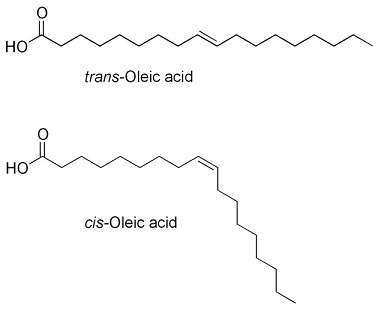Contents
What is a ‘trans-fat’?
The vast majority of trans-fats are synthetic, and they are not commonly found in nature. Trans-fats are characterised by a double bond which is in a ‘trans’ shape, and because of this, only poly-unsaturated and mono-unsaturated fats can be made into trans-fats because saturated fats contain no double bonds. A double bonds in fatty acids can exist in 2 forms – ‘cis’ which is very common in nature and ‘trans’. A cis double bond gives the fatty acid molecule a kink/ bend, which gives poly-unsaturated fats and mono-unsaturated fats some of their properties (such as being liquid at room temperature – think olive oil). Trans double bonds however, do not put a kink/ bend in the molecule giving them a straight structure similar to that of saturated fats. You can see in the image below that although trans-oleic acid and cis-oleic acid are chemically identical, they have a very different structure. This structural difference is the only difference between trans-fats and other fats.

What are trans-fats used for?
Trans-fats are used in the food industry to create specific properties in foods. The most popular use of trans-fats has been to create the ‘melt in your mouth’ feel of some chocolates and other treats. People love the feeling of food which begins to melt as soon as it touches your tongue, and so being able to create this was very desirable for food manufacturers. By adding trans double bonds to poly-unsaturated fats, you are able to straighten parts of the fatty acid, which is a key factor in determining the melting point. The more straight a fatty acids is, the higher the melting point is (think of lard at room temperature which is predominantly straight saturated fats). If you add the right amount of trans bonds to the right poly-unsaturated fat and you will make a fat which melts perfectly at body temperature. Being able to manipulate a fat to melt at a very precise temperature would be impressive if it wasn’t so toxic.
How do trans-fats affect the body?
Currently in the UK, the average individual will derive approximately 1% of their daily energy from trans-fats, which equates to roughly 2-3g a day. Trans-fats are known to cause inflammation, and increase circulating triglyceride in the blood, both of which are known to dramatically increase your risk of cardiovascular disease, and even consuming this seemingly small amount of trans-fats is known to significently increase your chances of developing cardiovascular problems. The potency of trans-fats can be seen in recent estimations which say that reducing trans-fat consumption to 0.5% of total energy would yield approximately 1,900 fewer deaths, 5,000 fewer hospital admissions, and gain approximately 18,000 life years1. Such a small decrease in trans-fats truly can have a dramatic benefit to the body.
Aside from increasing the risk of cardiovascular disease, trans-fat have also been linked to cognitive dysfunction such as dementia, as well as other diseases such as obesity, type 2 diabetes, and disruption of the endocrine system (hormones). Evidence is continuously mounting against trans-fats, and for once it seems like opinion is not divided – a healthy life is one without trans-fats.
Foods which contain trans-fats
A simple rule to follow is to avoid highly processed foods as these are most likely to contain trans-fats. Foods highest in trans-fats include:
- Chocolate (especially the ones which melt in your mouth)
- Pies and pastries
- biscuits and cookies
- Ice-creams
- Ready meals
- Some margarines
- Fried foods
Sadly, with increasing awareness about the negative impact trans-fats have on the body, food manufacturers are changing how they display the trans-fat content on the label. Instead of saying a particular food contains ‘X’ grams of trans-fats, they may say ‘X’ grams of hydrogenated or partially hydrogenated fats. These are the same thing as trans-fats, and trans-fats are made by a chemical reaction call hydrogenation. Don’t be fooled by the food label.
The exception to the rule
Trans-fats are not common in nature, but they are still found naturally in some foods. Interestingly naturally occurring trans-fats do not have the same impact on our health as synthetic trans-fats, in fact, quite the contrary. One of the most well known naturally occurring trans-fats is found in beef meat and milk is called conjugated linoleic acid (CLA), which is associated with a whole host of health benefits from aiding with fat loss to possible protection against some cancers.
Summary
The vast majority of trans-fats are synthetically made, and are present in highly processed foods such as chocolate and margarine, usually to make their texture more appealing. There is no doubt that these fats are toxic, and consumption of them should be avoided wherever possible as even the smallest reduction can have a significant benefit on your health. Trans-fats are very rarely found in nature, but where they are found naturally (such as CLA) they do not pose the same health threat as synthetic trans-fats, and may even exert health benefits.
References
Jonathan Pearson-Stuttard, Julia Critchley, Simon Capewell, Martin O’Flaherty. (2014). Quantifying the UK Benefits of reducing dietary trans fats: Modelling study.. 129 (1), 1.

